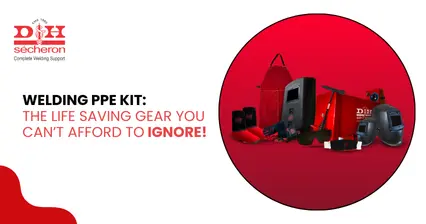What is Shielded Metal Arc Welding? It’s a process that is taken place manually and in that process, the required heat is generated using an electric arc to carry the procedure of welding. In other words, metal and steel are joined using electricity. During the welding process, the heat can even rise to 6500 degrees Fahrenheit. The prime reasons to carry out this process are - To maintain wear and tear heavy machinery, welding pipelines, and also to help in big-scale construction projects. When the process is done, a flux-like substance is formed around the weld that protects the substance from dirt and makes it firm.
There are 4 types of Arc Welding:
1) Shielded metal welding (SMAW): The requirements for smaw welding are simple and nominal and are generally used in wear & tear, repair, and construction processes.
2) Flux-cored arc welding (FCAW): This one is more expensive than the previous one. The reason behind this is its faster welding speed and metal penetration.
3) Gas metal arc welding (GMAW): The welding done with gas has a high speed but can’t be adapted easily.
4) Submerged arc welding (SAW): Here, the arc is underneath a layer of flux. This process is used to restrict the contact of contaminants.
Let’s look at the advantages and disadvantages of this process:
Pros:
1) Mobility: The materials used in the procedure are extremely easy to transport from one place to another. When it comes to Industrial and Manufacturing areas, mobility of the materials is of the essence.
2) Cost-effective: As compared to other processes, metal arc welding is less expensive. Since there is no gas in the process the required equipment is also less.
3) Apt for most metals: Another reason why Industries prefer arc welding is that it’s suitable for numerous metals and alloys.
4) Less Pollution: While the other methods of welding produce a lot of smoke and sparks, SMAW emits comparatively less smoke making it safe for human beings.
5) Resistant to corrosion: Arguably one of the best benefits of the process. Corrosion is a major challenge in manufacturing and many other industries and if the welding consumables are free from corrosion, it’s always an added advantage.
Cons:
1) Unsuitable for certain materials: SMAW is not suitable for thin-shaped materials. Since the temperature can rise to 6000 degrees Fahrenheit, it’s not advised for tiny materials that can’t sustain it.
2) Irreplaceable welding electrodes: The welding electrodes cannot be easily replaced. Once fixed, they can’t be replaced frequently hence one needs to be careful about it. Apart from that, the removal of slag from the weld becomes compulsory.
3) Low Deposition Rate: As compared to other methods like GMAW and FCAW, the deposition rate for Metal arc welding is quite low. Also, the entire process requires a high set of skills.
11 May 2025 | Welding
An In-Depth Exploration of Low-Alloy Steel: Your Comprehensive Guide
11 May 2025 | Welding
Nagpur - Bori - Tuljapur Road MSH-3 in Yavatmal District (Maharashtra)
11 May 2025 | Welding
Guidelines to Understand Gas Welding: Applications, Advantages & Disadvantages
11 May 2025 | Welding
3 Tips for Finding the Best Mild Steel Electrode for Your Application
11 May 2025 | Welding
How to Select the Right Welding Filler Wires for Stainless Steel Welding?
11 May 2025 | Welding
Building the Narendra Modi Stadium with Norma V and Autotherme-1 Electrodes
11 May 2025 | Welding
Low Alloy Steel Welding in a (PEB) Pre Engineered Building Structure
11 May 2025 | Welding
Welding Rods: Different Types and Tips for Properly Storing and Handling
11 May 2025 | Welding
Tips for Flawless Welds with Stainless Steel Electrodes: Pros and Cons
11 May 2025 | Welding
Exploring Applications and Benefits of Stainless Steel Welding Electrodes
11 May 2025 | Welding
Welding Basics: Joining Metals with Heat and Pressure - A Beginners Guide
11 May 2025 | Welding
Distinguishing Low-Alloy Steel from High-Alloy Steel: Understanding the Variations
11 May 2025 | Welding
Hard Facing Wire - Understanding the Process and Achieving Optimal Result
11 May 2025 | Welding
Exploring the Advantages of Stainless Steel Electrodes in Welding Applications
11 May 2025 | Welding
Weathering Steel vs. Traditional Steel: A Comparative Analysis of Performance
11 May 2025 | Welding
Choosing the Right Welding Rod: Why 6013 Electrodes Might Be Your Ideal Option
11 May 2025 | Welding
Why 7018 Electrodes Are Preferred for High-Strength Welds in Pipeline Construction
11 May 2025 | Welding
Filler Wire vs. Stainless Steel Filler Wire: Understanding the Key Differences
11 May 2025 | Welding
Exploring the Impact of Filler Material on Welding Quality and Durability
11 May 2025 | Welding
Choosing the Right Cast Iron Electrode for Different Welding Projects
11 May 2025 | Welding
Top Advantages of Cast Iron Electrodes for Industrial Welding Applications
11 May 2025 | Welding
Key Benefits and Challenges of Using TIG Welding in Industrial Projects
11 May 2025 | Welding
5 Reasons Why 7018 Electrode is the Gold Standard for Welding Professionals
11 May 2025 | Welding
Top 5 Advantages of Flux Cored Arc Welding for Heavy-Duty Applications.png)
11 May 2025 | Welding
Lotherme-601: A Game-Changer for Restoring Shoulder Pins in Heavy Machinery
11 May 2025 | Welding
How D&H Sécheron Helped Repair a Rotary Kiln’s Cooler Section with LoTherme 352
11 May 2025 | Welding
Piston Repair for Mining Industry: Cost-Effective Solutions with LoTherme 468.webp)






.jpg)







































.jpg)
.jpg)

.jpg)

.jpg)





.jpg)
.jpg)
.jpg)



.webp)
.jpg)
.jpg)
.webp)
.jpg)






















.png)



.webp)

.webp)
.webp)



